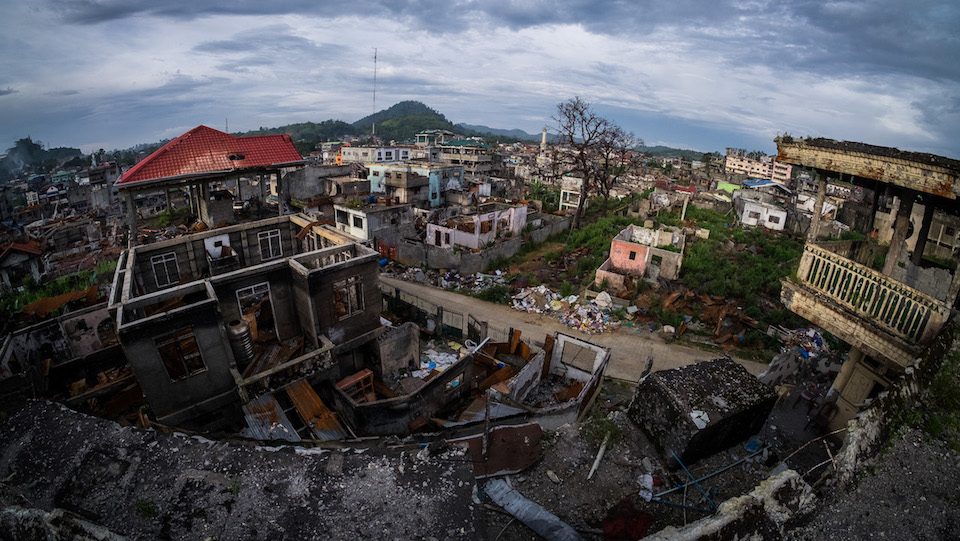SUMMARY
This is AI generated summarization, which may have errors. For context, always refer to the full article.

MANILA, Philippines – Experts are pushing for a community-led rehabilitation of Marawi City to ensure the success of the government’s multi-billion project at the site of fierce battles with local terrorist groups linked to Islamic State (ISIS).
The Asia Foundation published on Saturday, April 28, a paper that detailed community concerns and project risks – focusing on land issues – that could complicate reconstruction plans in the city.
“Land, including housing and property, is a make-or-break issue in the rehabilitation of Marawi City,” according to the 40-page paper “Community-Driven Rehabilitation is the Practical Thing to Do in Marawi: Critical Points for Addressing Land Issues,” released on Saturday.
There are concerns about a planned construction of a second military camp and proposed widening of roads inside the former battle area, for example. Land grabbing fears are also rampant – despite assurances from government – in the city known for its problematic land titles. (Q and A: Marawi rehab chief seeks to ease fears of land grabbing)
The paper said proposed developments may both have positive and negative effects. It is important that residents are part of these decisions so they may be willing to share the responsibilities and the risks.
The paper was authored by planning experts Ica Fernandez, David Garcia, and Assad Baunto. (Read the paper here.)
“The success or failure of rehabilitation will depend on the quality of participation and representation of communities in both planning and implementation,” the paper said.
“While most projects will be publicly financed, citizen-led placemaking should also be encouraged to maximized sustainability,” the paper said.
The government selected the proposal of a Chinese-led consortium for the rebuilding of the former battle area. But it will undergo a Swiss challenge, meaning other proposals could still be entertained. (LIST: 9 companies behind China-led consortium picked for Marawi rehab)

Land as historical trigger of wars
The paper stressed how land has been a historical trigger of wars in Mindanao, including the 2017 siege of Marawi where terrorists reportedly sought to establish a caliphate.
Failure to address land issues will not only risk the success of the rehabilitation plans. It could aid the narratives of continuing recruitment by terrorist groups, the paper warned.
The paper said land issues can be resolved best with “deeper participation and representation of traditional leaders and community members in mapmaking, decision-making, and placemaking across the formal and informal reconstruction mechanisms.”
“Community-driven rehabilitation can minimize potential animosities and tarnished maratabat (dignity), engage the root causes of dissatisfaction, and enable the clear and equitable sharing of risks, benefits, rights, duties between government, civilians, and the private sector,” the paper said.
The former battle area remains a ghost town 6 months since the war ended in October 2017. Up to 11,000 families are still displaced, a government estimate that excludes about 20,000 families more who used to rent there.
Residents were allowed this April to temporarily visit what is left of their homes before demolition is scheduled to begin in June. (READ: A painful homecoming for Marawi evacuees)
Marawi as Dansalan
The paper shows why it’s not only residents inside the former battle area who should be consulted when finalizing the rehabilitation plans.
Located at the city proper of Marawi, the former battle area used to be the heart of the province and even the region. It means regional stakeholders need to be consulted as well.
The paper said it is important to preserve Marawi’s role as Dansalan – “cultural, political, and economic melting pot and meeting place of all peoples inhabiting Lake Lanao.”
The paper also called for the construction of common spaces that will allow more interaction among the residents.
“To rebuild a truly peaceful and livable city, urban expansion in Marawi City should aim for building contiguous urban quarters instead of following strict zonal neighborhoods for the same set of users of space. Segregation goes against the traditional mixed-use urban structure common in Marawi,” the paper said.
“Strict commercial and residential zoning regulations may do more harm if it strips away the opportunity to be creative in trade at home and at neighborhood level,” it added.
The paper was published as the government is expected to decided on proposals for the rehabilitation plan.
The Marawi siege is to mark its first year on May 23. – Rappler.com
Add a comment
How does this make you feel?
There are no comments yet. Add your comment to start the conversation.